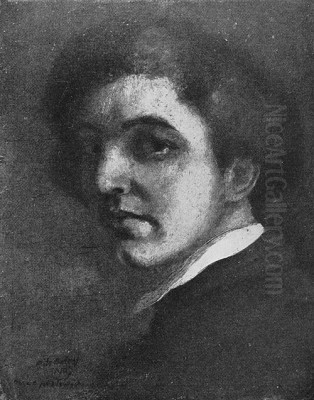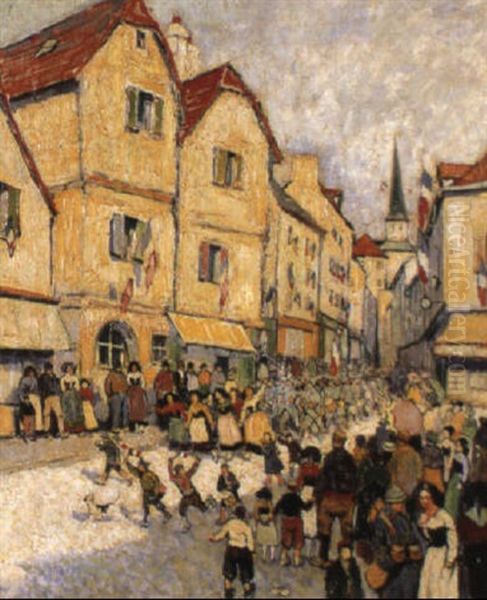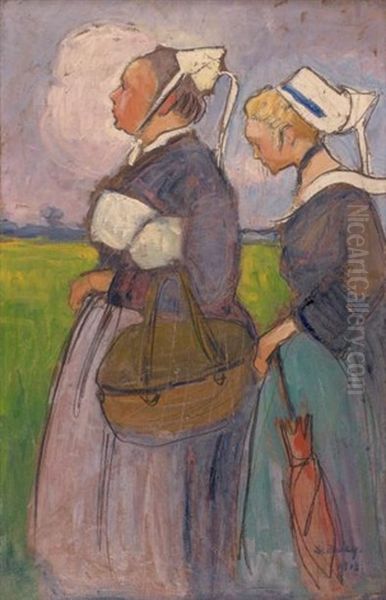
Pierre de Belay stands as a fascinating figure in early 20th-century French art. Born in 1890 and passing away in 1947, he navigated the vibrant and rapidly changing artistic landscape of his time, leaving behind a body of work characterized by its keen observation, stylistic versatility, and deep connection to both his native Brittany and the bustling heart of Paris. Primarily known as a painter, de Belay was also a skilled printmaker and a pioneering judicial illustrator, capturing the essence of French life from its picturesque coastlines to its dramatic courtrooms. His art forms a bridge between traditional representation and the burgeoning movements of Modernism, offering a unique window into his era.
Early Life and Artistic Formation in Brittany
Pierre de Belay's journey began in Quimper, a town in the Finistère department of Brittany, France. Born into an environment steeped in art, his path seemed almost preordained. His father was himself a painter, providing an early exposure to the creative process. Crucially, his father was also a friend of the influential poet, painter, and critic Max Jacob. This connection would prove pivotal in shaping the young artist's future. Growing up in Quimper, a region renowned for its distinct cultural identity, rich traditions, and dramatic landscapes, undoubtedly imprinted itself on de Belay's artistic sensibility from an early age.
While details of his formal education remain somewhat scarce, it is widely understood that Pierre de Belay was largely self-taught. His innate talent for drawing, painting, and even sculpting manifested early on. The artistic atmosphere of his family and hometown likely served as his primary classroom. The crucial turning point came through the family connection to Max Jacob. Still in his teens, around the age of fifteen, de Belay received an invitation from Jacob to come to Paris, the undisputed center of the art world at the time. This move marked the beginning of his immersion into a far more dynamic and challenging artistic milieu.
Montparnasse and the Parisian Avant-Garde

Arriving in Paris, Pierre de Belay quickly fell under the spell of the city's vibrant artistic life, particularly centered around the district of Montparnasse. Guided by Max Jacob, he was introduced to the leading figures and revolutionary ideas shaping modern art. Jacob, a key figure in the Cubist circle and a close friend to many artists, opened doors for the young Breton. De Belay encountered the works of Impressionists and Post-Impressionists, notably Paul Cézanne, whose structural approach to composition would resonate with his later work.
Through Jacob's network, de Belay came into contact with some of the most significant artists of the era. He met Pablo Picasso, the towering figure of Cubism, and even painted a portrait of him, indicating a level of acceptance and interaction within these avant-garde circles. He was also introduced to the renowned sculptor Auguste Rodin, further broadening his artistic horizons. His circle included writers and critics deeply involved in the art scene, such as Guillaume Apollinaire, another champion of Cubism, André Salmon, and Pierre Mac Orlan (often cited as Marc Orlan).
Despite rubbing shoulders with these luminaries and absorbing the influences swirling around Montparnasse – the energy of Fauvism, the structural innovations of Cubism, the expressive freedom gaining ground – de Belay maintained a distinct artistic independence. He associated with fellow Montparnasse figures like Amedeo Modigliani, Chaïm Soutine, Constantin Brancusi, Tsuguharu Foujita, and André Derain, yet he never fully subscribed to a single movement or dogma. He selectively integrated elements that resonated with his own vision, forging a personal style rather than becoming a disciple of a particular school. His time in Paris was crucial for his development, exposing him to radical new ways of seeing and representing the world.
A Unique Artistic Vision: Style and Techniques
Pierre de Belay's artistic output is notable for its stylistic diversity, reflecting his engagement with the various currents of early 20th-century art. His work often shows a synthesis of influences, blending elements of Impressionism in his attention to light and atmosphere, Expressionism in his sometimes bold brushwork and emotional content, and Cubism in his structured compositions and simplified forms. Hints of Fauvism can appear in his use of strong, non-naturalistic color, while a certain decorative quality, possibly influenced by the Art Deco sensibilities of the time, is also discernible.

He was not merely a painter adapting existing styles; de Belay actively experimented with technique. He developed a unique approach he termed "treillisme," or lattice-work. This technique involved building up the image through a network of intersecting lines and strokes of color, creating a textured, vibrant surface that simultaneously defined form and conveyed light. This method allowed him to maintain a sense of structure and drawing within his paintings, even while exploring expressive color and brushwork. It provided a way to organize the visual field, particularly effective in capturing the dynamic energy of crowds, markets, or coastal scenes.
Beyond oil painting, de Belay was proficient in various media. He worked extensively with watercolor and gouache, often on paper, producing works like La Libération with a fluidity and immediacy suited to the medium. Drawing, particularly with pencil, remained fundamental to his practice, underpinning his painted compositions and his work as an illustrator. Furthermore, de Belay embraced printmaking, specifically copperplate lithography. This technique not only offered a different textural quality but also served a practical purpose: it allowed his images, particularly his illustrations and scenes of daily life, to be reproduced and disseminated more widely and at a lower cost, bringing his art to a broader audience.
Chronicler of Life: Subjects and Themes
Pierre de Belay's art is deeply rooted in his observations of the world around him. His subject matter primarily revolves around two distinct poles: his native Brittany and the urban life of Paris, alongside his unique foray into the world of judicial proceedings. He was a keen observer of people and their environments, capturing the character and rhythm of daily existence.
Brittany remained a constant source of inspiration throughout his life. He returned annually to the Cornouailles region, immersing himself in its culture. His works frequently depict Breton landscapes, such as the painting Pont Croix 1939. He was particularly drawn to coastal life, painting scenes of harbors, fishing boats (Le Navire de Concarneau), and fishermen at work (Au travail sur la mer, l'attelage). The people of Brittany feature prominently, especially the women in their traditional coiffes and attire, as seen in his representative work Les Bretonnes. He captured market scenes, local festivals, and the simple, often rugged, life of the region with empathy and authenticity. Works like La charrette de pommes exemplify his focus on rural activities.
His Parisian subjects often reflected the vibrant, sometimes gritty, life of Montparnasse and the city's streets. Cafés, bars, theaters, and public spaces provided settings for his observations of urban society. While perhaps less documented than his Breton scenes in the provided texts, his immersion in the Parisian art world implies a familiarity with these environments. He captured the energy and social dynamics of the city, contrasting with the more traditional rhythms of Brittany.
Beyond these geographical anchors, de Belay explored historical and social themes. His watercolor La Libération suggests an engagement with contemporary events, likely depicting scenes related to the end of World War II. This interest in documenting significant moments connects directly to his groundbreaking work as a judicial illustrator, a role that set him apart from many of his contemporaries and provided him with unique subject matter.
The Judicial Illustrator
A remarkable and distinctive aspect of Pierre de Belay's career was his role as a judicial illustrator. Beginning around 1923 and continuing for several years, he became the first artist officially recognized to sketch within French courtrooms. This was a pioneering endeavor, offering the public visual insights into high-profile legal cases at a time before courtroom photography was common or permitted. He covered sensational trials that gripped the nation, including the case of Eugen Weidmann, a notorious serial killer executed in 1939, and the Stavisky Affair, a major financial and political scandal that rocked France in 1934.
De Belay's courtroom sketches were more than mere reportage; they were works of art in their own right, capturing the tension, drama, and human element of the judicial process. He depicted judges, lawyers, defendants, witnesses, and the public gallery, conveying the atmosphere of the courtroom through his dynamic lines and expressive style. This work required speed, accuracy, and an ability to capture character and emotion under pressure. His illustrations were published, bringing the faces and scenes of justice into French homes and solidifying his reputation as a versatile and engaged artist. This unique specialization provided him with unparalleled access to dramatic human narratives and further honed his skills in rapid observation and character study.
Career Development and Recognition
Pierre de Belay's artistic journey was one of persistent effort and gradual recognition, marked by a combination of commissioned work, independent creation, and public exhibition. An early significant commission came in 1923 for the Hôtel Ker-Moor in Bénodet, Brittany, suggesting an early establishment of his reputation, at least regionally. His work as an illustrator, both for the courts and for publications like the satirical magazine Harlequin, provided not only income but also visibility.
His path was not always straightforward. An anecdote mentions him working briefly in a shoe shop, a detail that underscores the often-precarious financial reality for artists, even talented ones, and highlights his diverse life experiences outside the studio. However, his dedication to his art eventually led to wider acclaim. The 1930s marked a period of increasing recognition within the Parisian art world. He participated in significant exhibitions, including a notable showing at the Rodin exhibition in 1930.
A key moment was his solo exhibition at the Gulot Gallery in 1936, which likely brought his work to the attention of a broader range of collectors and critics. He also exhibited at the Rotonde Gallery, another venue associated with the Montparnasse artists. These exhibitions helped solidify his standing as a respected, albeit independent, figure within the French art scene. He continued to divide his time between Paris and Brittany, maintaining studios and connections in both locations, and drawing inspiration from each contrasting environment until his death in 1947.
Market Presence and Legacy
During his lifetime, Pierre de Belay achieved a degree of market success. Records indicate that his paintings commanded respectable prices; for instance, works like Bretonnes were valued in the range of 5,000 to 6,000 francs, while Au travail sur la plage, l’attelage was estimated between 2,500 and 3,000 francs (contemporary values). This demonstrates that his unique blend of modern sensibilities and traditional subjects found favor with collectors. His use of copperplate lithography also contributed to his market presence by making his work more accessible.
After his death in 1947, the preservation of his artistic legacy was significantly aided by his widow, Hélène de Belay. She carefully conserved his extensive body of work and played a crucial role in ensuring its donation to public institutions. Today, Pierre de Belay's works are held in the collections of major French museums, including the prestigious Musée d'Orsay in Paris and the Musée de Bretagne in Rennes, as well as the Musée des Beaux-Arts in his hometown of Quimper, testifying to his enduring importance, particularly within the context of Breton art.
While perhaps not as globally famous as some of his avant-garde contemporaries like Picasso or Chagall (with whom he also associated through Max Jacob), de Belay's reputation has been sustained through continued interest and scholarly attention. Authentication services exist for his work, indicating an ongoing, if specialized, market. Crucially, his legacy has been revitalized by recent major exhibitions. In 2024, the museum in Quimper mounted a large retrospective showcasing over 200 works, covering his entire career and highlighting his dual life in Paris and Cornouailles, as well as his judicial illustrations. Another significant 2024 exhibition at Quimper's Historical Art Museum focused on his diverse output, including decorative arts. Publications, such as a dedicated book published in 2002 and educational materials accompanying the recent exhibitions, further contribute to the understanding and appreciation of his art.
Conclusion
Pierre de Belay emerges as a significant, multifaceted artist whose work captures the spirit of early 20th-century France. He skillfully navigated the currents of modern art, borrowing from Impressionism, Expressionism, and Cubism, yet forging his own independent path, notably marked by his "treillisme" technique. His deep connection to Brittany provided a rich vein of subject matter, resulting in evocative portrayals of its landscapes, people, and traditions. Simultaneously, his experiences in Paris, particularly in Montparnasse, infused his work with urban energy and connected him to the era's leading artistic minds, including Max Jacob, Picasso, Rodin, Apollinaire, and Chagall.
His unique role as a pioneering judicial illustrator sets him apart, showcasing his ability to capture intense human drama with immediacy and skill. Though perhaps overshadowed by more radical figures, de Belay's consistent output, technical versatility across painting, printmaking, and illustration, and his insightful chronicling of both regional identity and broader social scenes secure his place in French art history. Recent exhibitions and ongoing scholarly interest ensure that the distinctive voice and vision of Pierre de Belay continue to be heard and appreciated.